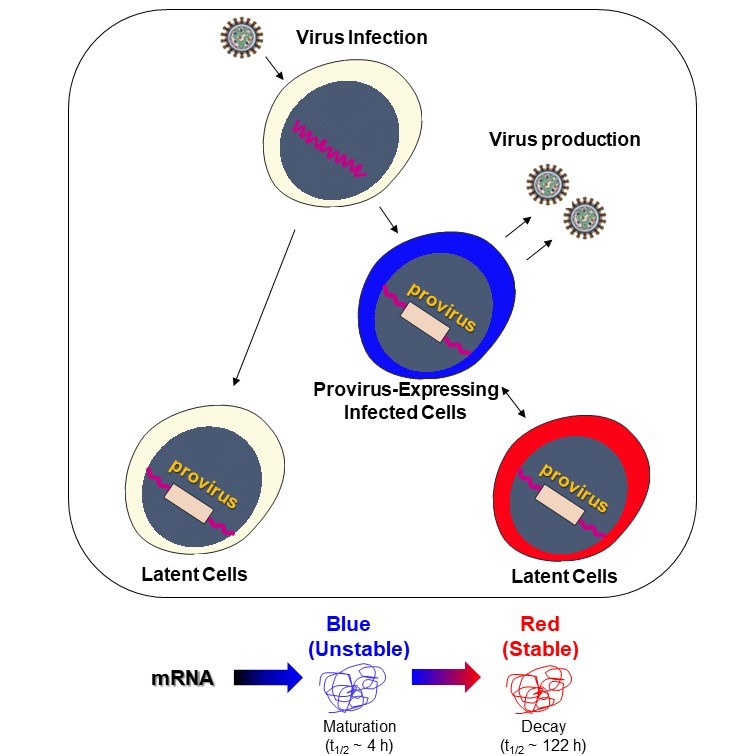New HIV Reporter Model: Visualizing HIV Viral Dynamics in Cells with Dual Fluorescence

Kumamoto University researchers have developed a novel viral reporter system named HIV-Tocky (Timer of Cell Kinetics and Activity). This innovative system allows for real-time visualization of HIV dynamics post-viral infection. Leveraging fluorescent timer protein technology, HIV-Tocky features dual fluorescence, shifting from blue to red, to illuminate the process of provirus silencing and reactivation. This enhanced temporal resolution surpasses that of conventional green fluorescence protein (GFP) systems, providing crucial insights into HIV-1 latency mechanisms and establishing a foundation for developing eradication strategies.The great challenge for the current standard HIV-1 cure strategy with combined anti-retroviral therapy (cART), is that while cART can inhibit reverse transcription, it cannot completely eradicate the virus-infected cells. Some infected cells harbor HIV-1 provirus that remains latent can escape the host immune system. If cART is interrupted, the provirus can reactivate under certain conditions, leading to progeny virion production and potentially reigniting the infection. "Understanding the dynamic transition of the HIV-1 provirus into latency is vital for developing eradication strategies, which is why we developed HIV-Tocky to analyze these temporal dynamics in vivo." said lead author Yorifumi Satou, professor at the Joint Research Center for Human Retrovirus Infection, Kumamoto University.
By synchronizing the emission spectrum change of the fluorescent timer protein with provirus expression, HIV-Tocky enables precise tracking of provirus temporal dynamics from expression to silence. This unique feature, with its highly sensitive fluorescence shift from blue to red, allows for the first-time identification of two latent patterns: a direct latency, and a latter latency which initially shows transient expression.

Two latent patterns identified by HIV-Tocky. Due to the 4-hour maturation half-life of the Timer protein's blue-to-red chromophore, we can detect reactivated or recently silenced proviruses with high sensitivity using Timer fluorescence. HIV-Tocky has identified two latent patterns: direct latency, and later latency which initially exhibits transient expression.
Further analysis on integration sites revealed these two latency patterns are governed by different regulatory determinants, with the former being more stochastic and the latter more epigenetically controlled, providing more clues regarding the molecular mechanism of provirus silencing and expression.
Overall, HIV-Tocky is a novel tool that captures the kinetics of provirus silencing, a feat not possible with GFP before, allowing for analysis of the complex nature of HIV-1 latency by revealing real-time dynamics of provirus expression. The study also demonstrated its potential for drug screening, particularly for the evaluation of Latency Promoting Agents (LPAs).
Dr. Satou noted that the next challenge will be to apply HIV-Tocky in primary myeloid and lymphoid cells, which may provide further information on latency dynamics and determinants across different tissues and anatomical reservoirs.
In addition to Dr. Satou’ team, the study authors include researchers from Alexandria University, Kagoshima University, Imperial College London and Tokyo Medical and Dental University (TMDU).
Reference
| Authors |
Omnia Reda, Kazuaki Monde, Kenji Sugata, Akhinur Rahman, Wajihah Sakhor, Samiul Alam Rajib, Sharmin Nahar Sithi, Benjy Jek Yang Tan, KokiNiimura, Chihiro Motozono, Kenji Maeda, Masahiro Ono, Hiroaki Takeuchi, Yorifumi Satou |
| Title of original paper | HIV-Tocky system to visualize proviral expression dynamics |
| Journal | communications biology |
| DOI | 10.1038/s42003-024-06025-8 |

